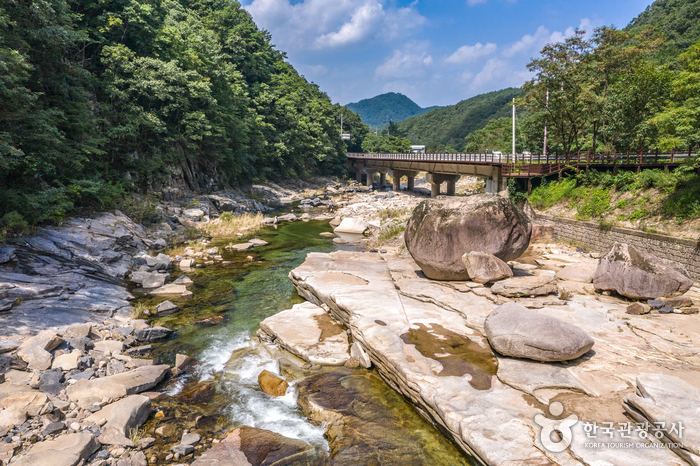Valle Seonam (선암계곡(하선암))
19.7Km 2025-12-29
Seonamgyegok-ro 1337, Danseong-myeon, Danyang-gun, Chungcheongbuk-do.
En el valle Seonam hay tres de las Ocho Maravillas de Danyang: las rocas Sangseonam, Jungseonam y Haseonam. Las aguas del valle corren desde la base del monte Woraksan, y gracias a que es un valle grande y está lleno de rocas de formas interesantes, es muy famoso. Se dice que el área en la que está la roca Haseonam es la más preciosa del valle. Esta roca blanca, dividida en 3 capas horizontales, tiene una longitud de 3 km, y sobre ella, hay otras grandes rocas de forma redonda. El modo en que el área se funde con las montañas del entorno es especialmente hermoso en primavera, cuando las azaleas florecen, y otoño, cuando las hojas se tiñen de diferentes colores. En la zona de la roca Haseonam, hay lugares en que uno puede pasar la noche.
Dejando atrás la roca Haseonam, se presenta la roca Jungseonam, donde la corriente del agua no es rápida y los numerosos árboles suministran sombra, así que puede bañarse en estas aguas. Sin embargo, no es un lugar adecuado para pasar la noche. Desde la roca Jungseonam, si remonta el curso del río, arribará a la roca Sangseonam. Esta muestra formas interesantes, y si avanza un poco más arriba, podrá ver la roca Teukseonam. La roca Teukseonam tiene instalaciones donde pasar la noche. Es uno de los mejores sitios donde se puede disfrutar de la vista de rocas llamativas y aguas cristalinas en el valle, así como también para descansar. Los turistas que buscan la frescura de los valles y el agua de la montaña, lo suelen visitar especialmente en verano.
Festival del Pez de Agua Dulce de Bonghwa (봉화은어축제)
19.7Km 2025-07-07
Naeseong-ri 506, Bonghwa-eup, Bonghwa-gun, Gyeongsangbuk-do
054-674-3053
El Festival del Pez de Agua Dulce de Bonghwa, que se celebra en el municipio de Bonghwa-gun, en la provincia de Gyeongsangbuk-do, ofrece numerosos programas interactivos que incluyen la pesca de pez dulce, carreras bajo agua y concursos de preguntas. La pesca del pez dulce, que tiene lugar dos veces al día en días laborables y tres veces los sábados, es la actividad más famosa del festival. Los ganadores de las carreras bajo agua y de los concursos de preguntas reciben especialidades locales como premio. Además, hay varios eventos educativos y culturales, tales como una exhibición de diversas especies de peces, un centro ecológico sobre el pez dulce en el que los visitantes pueden observar el hábitat natural del pez, el Museo de Moneda Coreana, el Centro Turístico Fotográfico de Bonghwa, pinturas sobre el pez dulce, cerámica, artesanías de hanji (papel tradicinal coreano), e inscripción en piedras.

 Español
Español
 한국어
한국어 English
English 日本語
日本語 中文(简体)
中文(简体) Deutsch
Deutsch Français
Français Русский
Русский